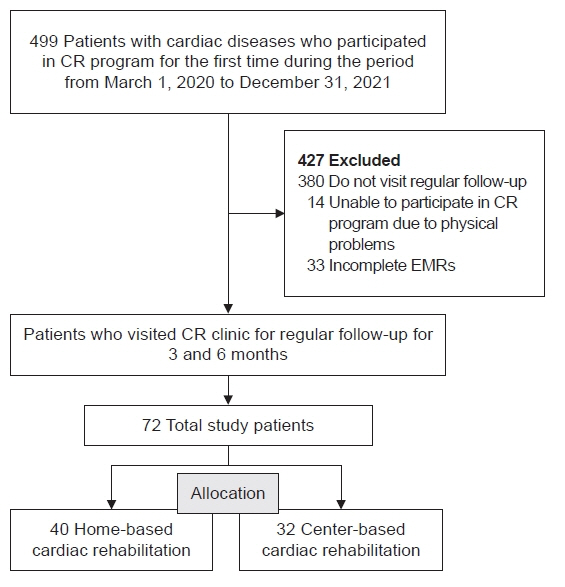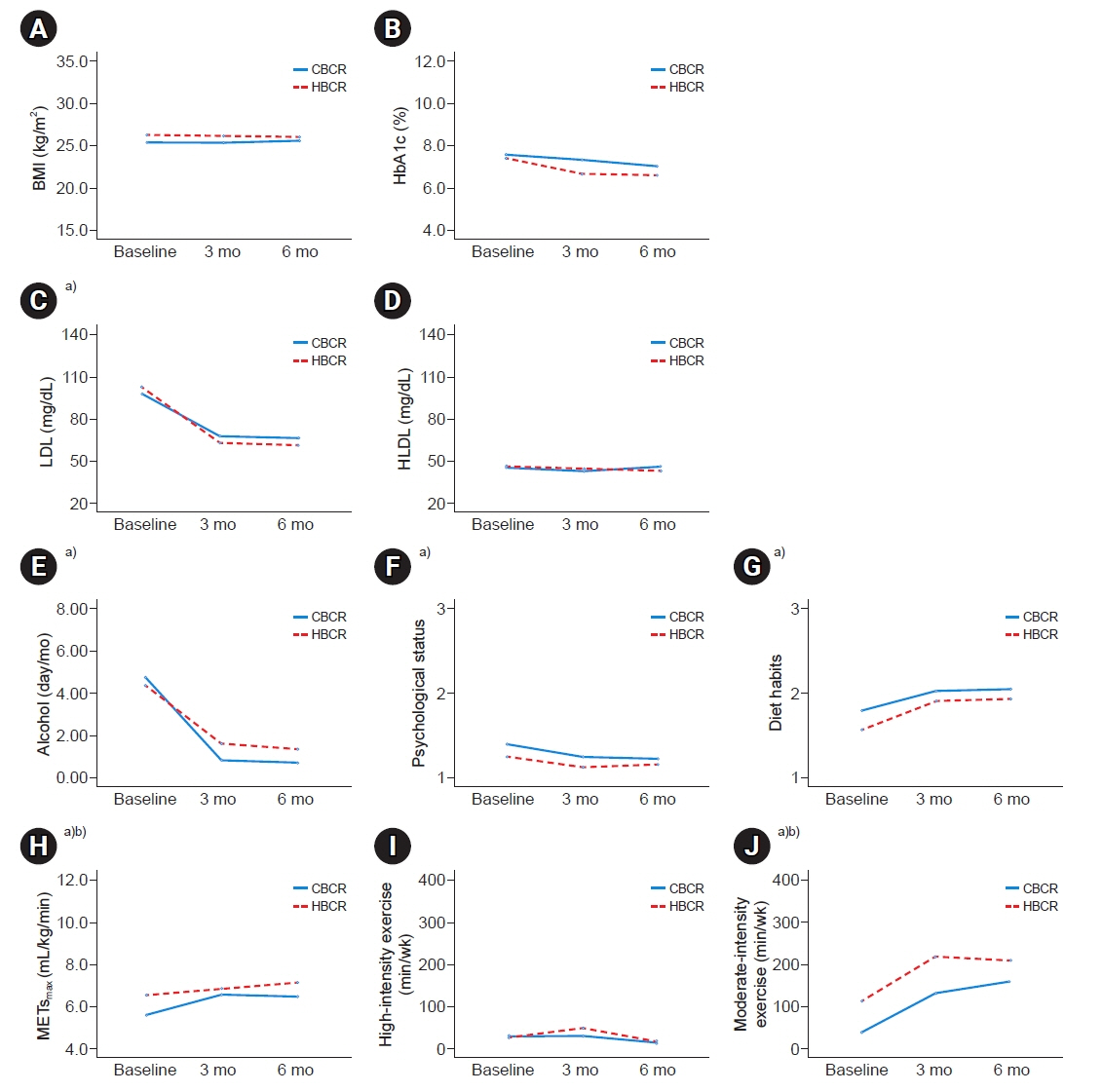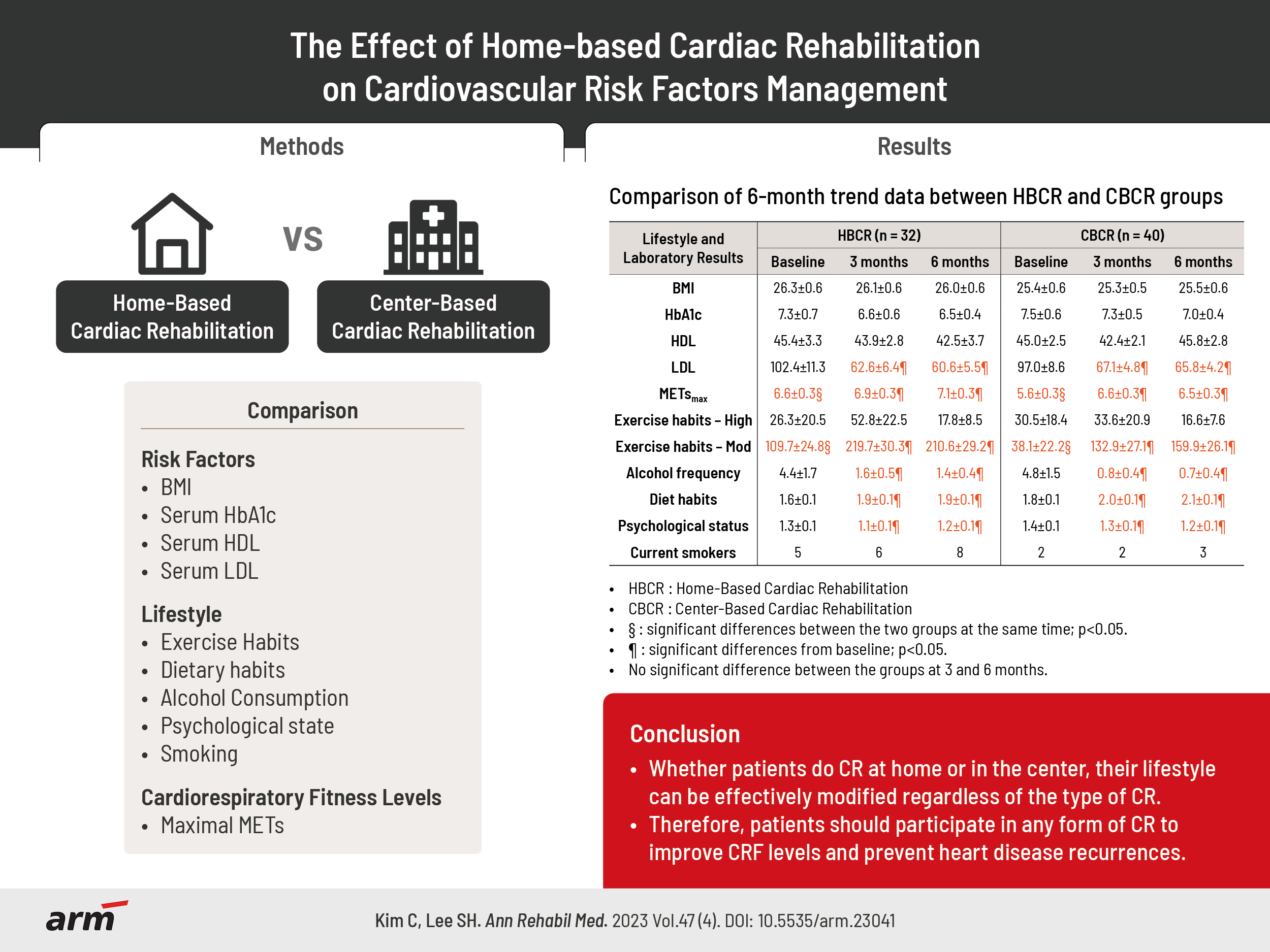Ann Rehabil Med.
2023 Aug;47(4):272-281. 10.5535/arm.23041.
The Effect of Home-Based Cardiac Rehabilitation on Cardiovascular Risk Factors Management
- Affiliations
-
- 1Department of Rehabilitation Medicine, Sanggye Paik Hospital, Inje University College of Medicine, Seoul, Korea
- KMID: 2545323
- DOI: http://doi.org/10.5535/arm.23041
Abstract
Objective
To compare the efficacy of home-based cardiac rehabilitation (HBCR) and center-based cardiac rehabilitation (CBCR) in cardiovascular risk factor management.
Methods
We performed retrospective review of the electronic medical records of 72 patients who were hospitalized for acute coronary syndrome and participated in a cardiac rehabilitation (CR) program for the first time. The participants were stratified into the HBCR group, receiving educational programs and performing self-exercise at home, and the CBCR group, participating in electrocardiogram monitoring monitoring exercise training in hospital settings. The results of the Lifestyle Questionnaire survey were investigated at baseline, 3 months, and 6 months.
Results
Both groups showed significant improvements in serum low-density lipoprotein levels, frequency of alcohol consumption, eating habits and psychological status. Moderate-intensity exercise duration and the maximal metabolic equivalents values improved significantly in both groups but slightly more in the CBCR group. However, the number of current smokers increased in both groups, and no significant changes were found in body mass index, serum glycated hemoglobin levels, serum high-density lipoprotein levels, or high-intensity exercise duration.
Conclusion
Regardless of the CR program type, a patient’s lifestyle can be modified. Therefore, patients should continue participating in any type of CR program.
Keyword
Figure
Reference
-
1. Urbinati S, Tonet E. Cardiac rehabilitation after STEMI. Minerva Cardioangiol. 2018; 66:464–70.
Article2. McMahon SR, Ades PA, Thompson PD. The role of cardiac rehabilitation in patients with heart disease. Trends Cardiovasc Med. 2017; 27:420–5.
Article3. Ramachandran HJ, Jiang Y, Tam WWS, Yeo TJ, Wang W. Effectiveness of home-based cardiac telerehabilitation as an alternative to Phase 2 cardiac rehabilitation of coronary heart disease: a systematic review and meta-analysis. Eur J Prev Cardiol. 2022; 29:1017–43.
Article4. Ruano-Ravina A, Pena-Gil C, Abu-Assi E, Raposeiras S, van 't Hof A, Meindersma E, et al. Participation and adherence to cardiac rehabilitation programs. A systematic review. Int J Cardiol. 2016; 223:436–43.
Article5. Ades PA, Keteyian SJ, Wright JS, Hamm LF, Lui K, Newlin K, et al. Increasing cardiac rehabilitation participation from 20% to 70%: a road map from the Million Hearts cardiac rehabilitation collaborative. Mayo Clin Proc. 2017; 92:234–42.
Article6. Taylor RS, Dalal H, Jolly K, Zawada A, Dean SG, Cowie A, et al. Home-based versus centre-based cardiac rehabilitation. Cochrane Database Syst Rev. 2015; (8):CD007130.
Article7. Anderson L, Sharp GA, Norton RJ, Dalal H, Dean SG, Jolly K, et al. Home-based versus centre-based cardiac rehabilitation. Cochrane Database Syst Rev. 2017; 6:CD007130.
Article8. Chu DJ, Al Rifai M, Virani SS, Brawner CA, Nasir K, Al-Mallah MH. The relationship between cardiorespiratory fitness, cardiovascular risk factors and atherosclerosis. Atherosclerosis. 2020; 304:44–52.
Article9. Bhat AG, Farah M, Szalai H, Lagu T, Lindenauer PK, Visintainer P, et al. Evaluation of the American Association of Cardiovascular and Pulmonary Rehabilitation exercise risk stratification classification tool without exercise testing. J Cardiopulm Rehabil Prev. 2021; 41:257–63.
Article10. Trabulo M, Mendes M, Mesquita A, Seabra-Gomes R. [Does the modified Bruce protocol induce physiological stress equal to that of the Bruce protocol?]. Rev Port Cardiol. 1994; 13:753–6. 753-60; 735-6. Portuguese.11. National Health Insurance Service. Health checkup questionnaire [Internet]. Wonju: National Health Insurance Service;[cited 2023 Jun 21]. Available from: https://www.nhis.or.kr/nhis/healthin/wbhaca04500m01.do.12. Chindhy S, Taub PR, Lavie CJ, Shen J. Current challenges in cardiac rehabilitation: strategies to overcome social factors and attendance barriers. Expert Rev Cardiovasc Ther. 2020; 18:777–89.
Article13. Ornish D, Scherwitz LW, Billings JH, Brown SE, Gould KL, Merritt TA, et al. Intensive lifestyle changes for reversal of coronary heart disease. JAMA 1998;280:2001-7. Erratum in: JAMA. 1999; 281:1380.14. Schwaab B, Zeymer U, Jannowitz C, Pittrow D, Gitt A. Improvement of low-density lipoprotein cholesterol target achievement rates through cardiac rehabilitation for patients after ST elevation myocardial infarction or non-ST elevation myocardial infarction in Germany: results of the PATIENT CARE registry. Eur J Prev Cardiol. 2019; 26:249–58.
Article15. Wilson PW. Cardiac rehabilitation and getting to lipid goals. J Cardiopulm Rehabil. 2005; 25:264–5.
Article16. Snow R, LaLonde M, Hindman L, Falko J, Caulin-Glaser T. Independent effect of cardiac rehabilitation on lipids in coronary artery disease. J Cardiopulm Rehabil. 2005; 25:257–61. quiz 262-3.
Article17. Athyros VG, Liberopoulos EN, Mikhailidis DP, Papageorgiou AA, Ganotakis ES, Tziomalos K, et al. Association of drinking pattern and alcohol beverage type with the prevalence of metabolic syndrome, diabetes, coronary heart disease, stroke, and peripheral arterial disease in a Mediterranean cohort. Angiology. 2007; 58:689–97.
Article18. Huntgeburth M, Ten Freyhaus H, Rosenkranz S. Alcohol consumption and hypertension. Curr Hypertens Rep. 2005; 7:180–5.
Article19. Steptoe A, Kivimäki M. Stress and cardiovascular disease. Nat Rev Cardiol. 2012; 9:360–70.
Article20. Salehi N, Janjani P, Tadbiri H, Rozbahani M, Jalilian M. Effect of cigarette smoking on coronary arteries and pattern and severity of coronary artery disease: a review. J Int Med Res. 2021; 49:3000605211059893.
Article21. Cameron AA, Davis KB, Rogers WJ. Recurrence of angina after coronary artery bypass surgery: predictors and prognosis (CASS Registry). Coronary Artery Surgery Study. J Am Coll Cardiol. 1995; 26:895–9.22. Kim C, Choi HE, Jang JH, Song JH, Kim BO. Do patients maintain proper long-term cardiopulmonary fitness levels after cardiac rehabilitation? A retrospective study using medical records. Ann Rehabil Med. 2021; 45:150–9.
Article23. Aguiar Rosa S, Abreu A, Marques Soares R, Rio P, Filipe C, Rodrigues I, et al. Cardiac rehabilitation after acute coronary syndrome: do all patients derive the same benefit? Rev Port Cardiol. 2017; 36:169–76.
Article24. Varnfield M, Karunanithi M, Lee CK, Honeyman E, Arnold D, Ding H, et al. Smartphone-based home care model improved use of cardiac rehabilitation in postmyocardial infarction patients: results from a randomised controlled trial. Heart. 2014; 100:1770–9.
Article25. Li J, Li Y, Gong F, Huang R, Zhang Q, Liu Z, et al. Effect of cardiac rehabilitation training on patients with coronary heart disease: a systematic review and meta-analysis. Ann Palliat Med. 2021; 10:11901–9.
Article
- Full Text Links
- Actions
-
Cited
- CITED
-
- Close
- Share
- Similar articles
-
- Cardiac Rehabilitation in Patients with Coronary Artery Disease
- The Accessibility and Effect of Cardiac Rehabilitation in COVID-19 Pandemic Era
- Analyses of Studies on Cardiac Rehabilitation for Patients with Cardiovascular Disease in Korea
- Guidelines for Cardiac Rehabilitation
- Overview of cardiac rehabilitation




